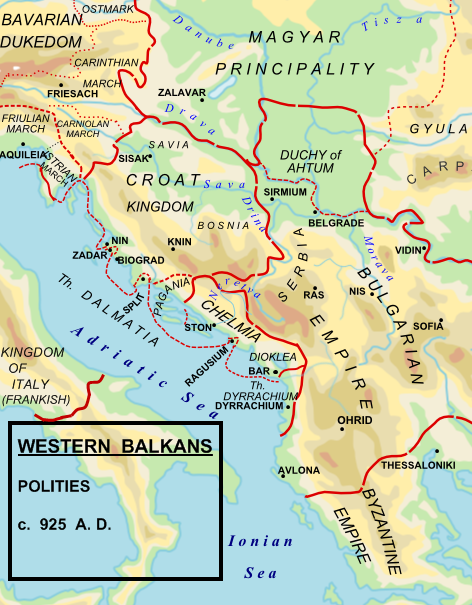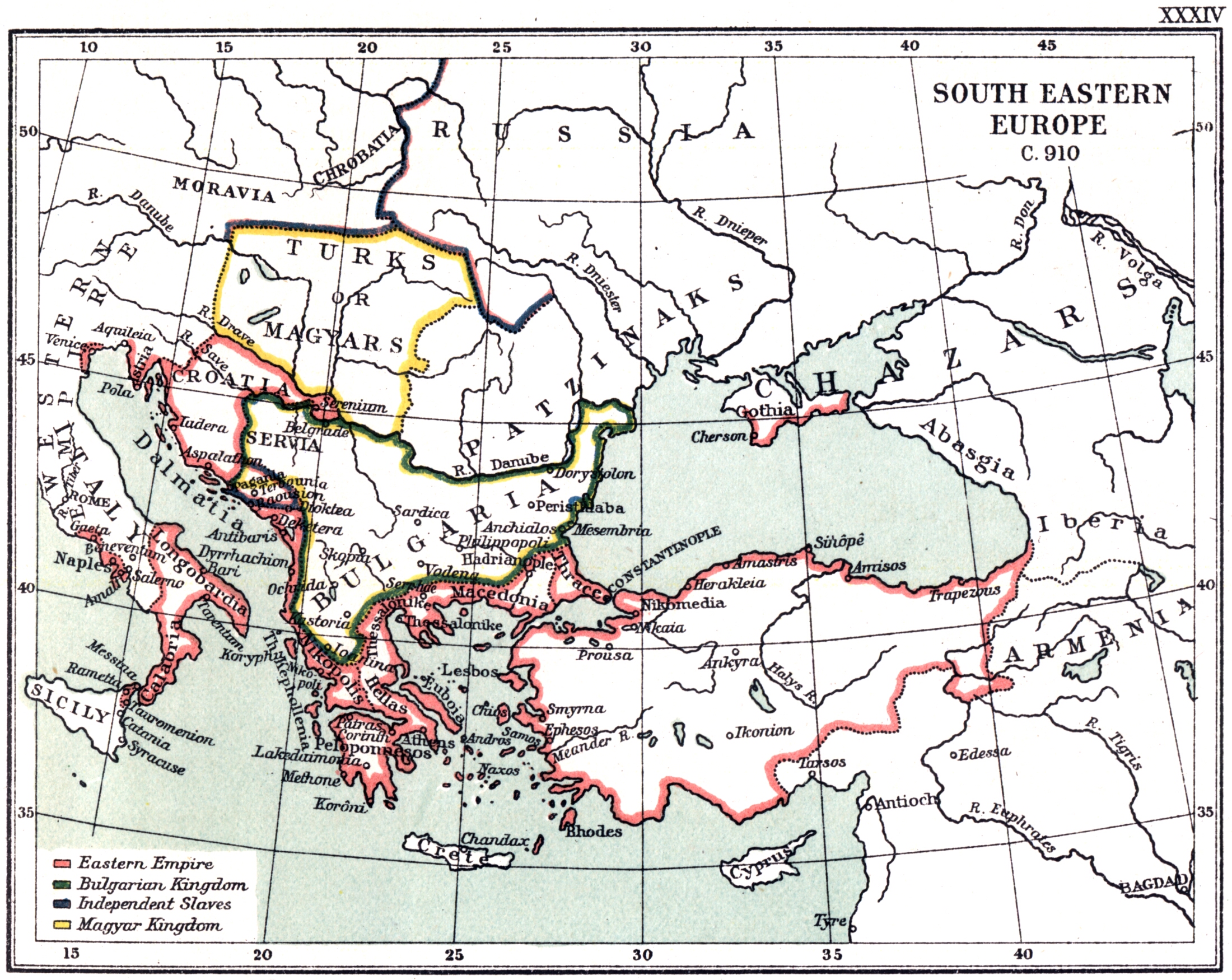|
Zaharija Of Serbia
Zaharija Pribislavljević or Zaharija of Serbia ( sr-cyr, Захаријa Прибислављевић, gr, Ζαχαρίας ; 890s – 924) was Prince of the Serbs from 922 to 924. He defeated his cousin Pavle in 922. Zaharija was the son of Pribislav, the eldest son of Mutimir (r. 851–891) of the first Serbian dynasty (ruling since the early 7th century). Life Early His father, Pribislav, ruled Serbia from 891 to 892 until his nephew, Petar, the son of Gojnik, returned from exile and defeated him in battle, ruling Serbia from 892 to 917. Pribislav fled to Croatia with his brothers Bran and Stefan. Bran later returned and led an unsuccessful rebellion against Petar in 894. Bran was defeated, captured and blinded ( blinding was a Byzantine tradition meant to disqualify a person from taking the throne). Pribislav lived in Constantinople. The Byzantine–Bulgarian Wars made the First Bulgarian Empire ''de facto'' the most powerful Empire of Southeastern Europe. The Bulga ... [...More Info...] [...Related Items...] OR: [Wikipedia] [Google] [Baidu] |
List Of Serbian Monarchs
This is an archontological list of Serbian monarchs, containing monarchs of the medieval principalities, to heads of state of modern Serbia. The Serbian monarchy dates back to the Early Middle Ages. The Serbian royal titles used include Knyaz (Prince), Grand Župan (Grand Prince), King, Tsar (Emperor) and Despot. Early medieval Serbian states (7th century–1166) Vlastimirović dynasty (7th century–960) The Vlastimirović dynasty was the first royal dynasty of the Serb people. Byzantine emperor Constantine VII ''Porphyrogenitus'' (r. 913–959) mentions that the Serbian throne is inherited by ''the son'', i.e. the first-born, though in his enumeration of Serbian monarchs, on one occasion there was a triumvirate. ,, The Serbs established several polities by the 10th century: ''Serbia'' or ''Zagorje'' (''hinterlands'') which consisted of ''Serbia'' (known as "Rascia" in historiography of the High Middle Ages), and Bosnia; and ''Pomorje'' (''maritime'') which consist ... [...More Info...] [...Related Items...] OR: [Wikipedia] [Google] [Baidu] |
Byzantine–Bulgarian Wars
The Byzantine–Bulgarian wars were a series of conflicts fought between the Byzantines and Bulgarians which began when the Bulgars first settled in the Balkan peninsula in the 5th century, and intensified with the expansion of the Bulgarian Empire to the southwest after 680 AD. The Byzantines and Bulgarians continued to clash over the next century with variable success, until the Bulgarians, led by Krum, inflicted a series of crushing defeats on the Byzantines. After Krum died in 814, his son Omurtag negotiated a thirty-year peace treaty. Simeon I had multiple successful campaigns against the Byzantines during his rule from 893 to 927. His son Peter I negotiated another long-lasting peace treaty. His rule was followed by a period of decline of the Bulgarian state. In 971 John I Tzimiskes, the Byzantine emperor, subjugated much of the weakening Bulgarian Empire by defeating Boris II and capturing Preslav, the Bulgarian capital. Samuel managed to stabilize the Bulgarian state w ... [...More Info...] [...Related Items...] OR: [Wikipedia] [Google] [Baidu] |
Vladimir Ćorović
Vladimir Ćorović ( sr-cyrl, Владимир Ћоровић; 27 October 1885 – 12 April 1941) was a Serbian historian, university professor, author, and academic. His bibliography consists of more than 1000 works. Several of his books on the history of Serbs, Bosnia, Yugoslavia and Herzegovina uprising are considered to be definitive works on the subject. Biography Education Vladimir Ćorović was born in Mostar in Herzegovina, then under Ottoman sovereignty but under Austro-Hungarian administration, to a prominent Serb Orthodox family involved in business. Ćorović finished primary school and the Gymnasium in Mostar, in which he was one of many future Serb intellectuals, among whom was also his brother the novelist Svetozar Ćorović. Ćorović continued his studies at the University of Vienna in 1904, studying Slavic Archaeology, History and Philology. He was active in the Serbian academic group „Zora“. Ćorović gained a Ph.D. in 1908 with a thesis on Lukijan ... [...More Info...] [...Related Items...] OR: [Wikipedia] [Google] [Baidu] |
Tomislav Of Croatia
Tomislav (, la, Tamisclaus) was the first king of Croatia. He became Duke of Croatia and was crowned king in 925, reigning until 928. During Tomislav's rule, Croatia forged an alliance with the Byzantine Empire against Bulgaria. Croatia's struggles with the First Bulgarian Empire eventually led to war, which culminated in the decisive Battle of the Bosnian Highlands in 926. In the north, Croatia often clashed with the Principality of Hungary; the state retained its borders and, to some extent, expanded with the disintegrated Lower Pannonia. Tomislav attended the 925 Council of Split, convened by Pope John X, to discuss the use of Slavic languages in liturgy, and ecclesiastical jurisdiction over both Croatia and the Byzantine Theme of Dalmatia. Although the Pope sought to prohibit Slavic liturgy, the council did not agree. Jurisdiction over the region was given to the Archbishop of Split instead of Bishop Gregory of Nin. Since historical information on Tomislav is scarce, the ... [...More Info...] [...Related Items...] OR: [Wikipedia] [Google] [Baidu] |
Michael Of Zahumlje
Michael of Zahumlje (reign usually dated c. 910–935), also known as Michael Višević (Serbo-Croatian: ''Mihailo Višević'', Serbian Cyrillic: Михаило Вишевић) or rarely as Michael Vuševukčić,Mihanovich, ''The Croatian nation in its struggle for freedom and independence: a symposium'', p. 112 was a semi-independent, or independent Slavic ruler of Zahumlje, in present-day central Herzegovina and southern Croatia, who flourished in the early part of the 10th century. Prince Michael of Zahumlje had a common boundary with the Serbia and probably with the Kingdom of Croatia, but was an ally of Bulgaria. He was nevertheless able to maintain independent rule throughout at least a good part of his reign. Michael came into territorial conflict with Petar of Serbia, who expand his power to the province of Narenta or Pagania, west from the Neretva River. To eliminate the threat, Michael warned his ally, the Bulgarian Tsar Simeon I, about the alliance between Peter and ... [...More Info...] [...Related Items...] OR: [Wikipedia] [Google] [Baidu] |
Thrace
Thrace (; el, Θράκη, Thráki; bg, Тракия, Trakiya; tr, Trakya) or Thrake is a geographical and historical region in Southeast Europe, now split among Bulgaria, Greece, and Turkey, which is bounded by the Balkan Mountains to the north, the Aegean Sea to the south, and the Black Sea to the east. It comprises southeastern Bulgaria (Northern Thrace), northeastern Greece (Western Thrace), and the European part of Turkey ( East Thrace). The region's boundaries are based on that of the Roman Province of Thrace; the lands inhabited by the ancient Thracians extended in the north to modern-day Northern Bulgaria and Romania and to the west into the region of Macedonia. Etymology The word ''Thrace'' was first used by the Greeks when referring to the Thracian tribes, from ancient Greek Thrake (Θρᾴκη), descending from ''Thrāix'' (Θρᾷξ). It referred originally to the Thracians, an ancient people inhabiting Southeast Europe. The name ''Europe'' first referred to ... [...More Info...] [...Related Items...] OR: [Wikipedia] [Google] [Baidu] |
Romanos I Lekapenos
Romanos I Lekapenos ( el, Ρωμανός Λεκαπηνός; 870 – 15 June 948), Latinisation of names, Latinized as Romanus I Lecapenus, was Byzantine emperor from 920 until his deposition in 944, serving as regent for the infant Constantine VII. Origin Romanos Lekapenos, born in Lakape (later Laqabin (West Syriac diocese), Laqabin) between Melitene and Samosata (hence the name), was the son of an Armenian peasant with the remarkable name of Theophylact the Unbearable (Theophylaktos Abastaktos). However, according to the Byzantinist Anthony Kaldellis, Romanos is discussed in many Byzantine sources, but none of them calls him an Armenian. His father came from humble origin and that's the reason he was assumed to have been Armenian. This alleged ethnicity has been repeated so often in literature that it has acquired the status of a known fact, even though it is based on the most tenuous of indirect connections. Nevertheless, his father Theophylact, as a soldier, had rescued the ... [...More Info...] [...Related Items...] OR: [Wikipedia] [Google] [Baidu] |
Simeon I Of Bulgaria
Tsar Simeon (also Symeon) I the Great ( cu, цѣсар҄ь Сѷмеѡ́нъ А҃ Вели́къ, cěsarĭ Sỳmeonŭ prĭvŭ Velikŭ bg, цар Симеон I Велики, Simeon I Veliki el, Συμεών Αʹ ὁ Μέγας, Sumeṓn prôtos ho Mégas) ruled over Bulgaria from 893 to 927,Lalkov, ''Rulers of Bulgaria'', pp. 23–25. during the First Bulgarian Empire. Simeon's successful campaigns against the Byzantines, Magyars and Serbs led Bulgaria to its greatest territorial expansion ever, making it the most powerful state in contemporary Eastern and Southeast Europe. His reign was also a period of unmatched cultural prosperity and enlightenment later deemed the Golden Age of Bulgarian culture. During Simeon's rule, Bulgaria spread over a territory between the Aegean, the Adriatic and the Black Sea.Bakalov, ''Istorija na Bǎlgarija'', "Simeon I Veliki". The newly independent Bulgarian Orthodox Church became the first new patriarchate besides the Pentarchy, and Bulgarian ... [...More Info...] [...Related Items...] OR: [Wikipedia] [Google] [Baidu] |
Battle Of Achelous (917)
The Battle of Achelous or Acheloos ( bg, Битката при Ахелой, el, Μάχη του Αχελώου), also known as the Battle of Anchialus,Stephenson (2004), p. 23 took place on 20 August 917, on the Achelous river near the Bulgarian Black Sea coast, close to the fortress Tuthom (modern Pomorie) between Bulgarian and Byzantine forces. The Bulgarians obtained a decisive victory which not only secured the previous successes of Simeon I, but made him ''de facto'' ruler of the whole Balkan Peninsula, excluding the well-protected Byzantine capital Constantinople and the Peloponnese. The battle, which was one of the biggest and bloodiest battles of the European Middle Ages, was one of the worst disasters ever to befall a Byzantine army, and conversely one of the greatest military successes of Bulgaria.Haldon (2008), p. 92 Among the most significant consequences was the official recognition of the imperial title of the Bulgarian monarchs, and the consequent affirmation ... [...More Info...] [...Related Items...] OR: [Wikipedia] [Google] [Baidu] |
Anatolia
Anatolia, tr, Anadolu Yarımadası), and the Anatolian plateau, also known as Asia Minor, is a large peninsula in Western Asia and the westernmost protrusion of the Asian continent. It constitutes the major part of modern-day Turkey. The region is bounded by the Turkish Straits to the northwest, the Black Sea to the north, the Armenian Highlands to the east, the Mediterranean Sea to the south, and the Aegean Sea to the west. The Sea of Marmara forms a connection between the Black and Aegean seas through the Bosporus and Dardanelles straits and separates Anatolia from Thrace on the Balkan peninsula of Southeast Europe. The eastern border of Anatolia has been held to be a line between the Gulf of Alexandretta and the Black Sea, bounded by the Armenian Highlands to the east and Mesopotamia to the southeast. By this definition Anatolia comprises approximately the western two-thirds of the Asian part of Turkey. Today, Anatolia is sometimes considered to be synonymous with Asian ... [...More Info...] [...Related Items...] OR: [Wikipedia] [Google] [Baidu] |
Arabs
The Arabs (singular: Arab; singular ar, عَرَبِيٌّ, DIN 31635: , , plural ar, عَرَب, DIN 31635, DIN 31635: , Arabic pronunciation: ), also known as the Arab people, are an ethnic group mainly inhabiting the Arab world in Western Asia, North Africa, the Horn of Africa, and the western List of islands in the Indian Ocean, Indian Ocean islands (including the Comoros). An Arab diaspora is also present around the world in significant numbers, most notably in the Americas, Western Europe, Arabs in Turkey, Turkey, Arab Indonesians, Indonesia, and Iranian Arabs, Iran. In modern usage, the term "Arab" tends to refer to those who both Arab identity, carry that ethnic identity and speak Arabic as their native language. This contrasts with the narrower traditional definition, which refers to the descendants of the tribes of Arabia. The religion of Islam was developed in Arabia, and Classical Arabic serves as the language of Islamic literature. 93 percent of Arabs are Muslims ... [...More Info...] [...Related Items...] OR: [Wikipedia] [Google] [Baidu] |







